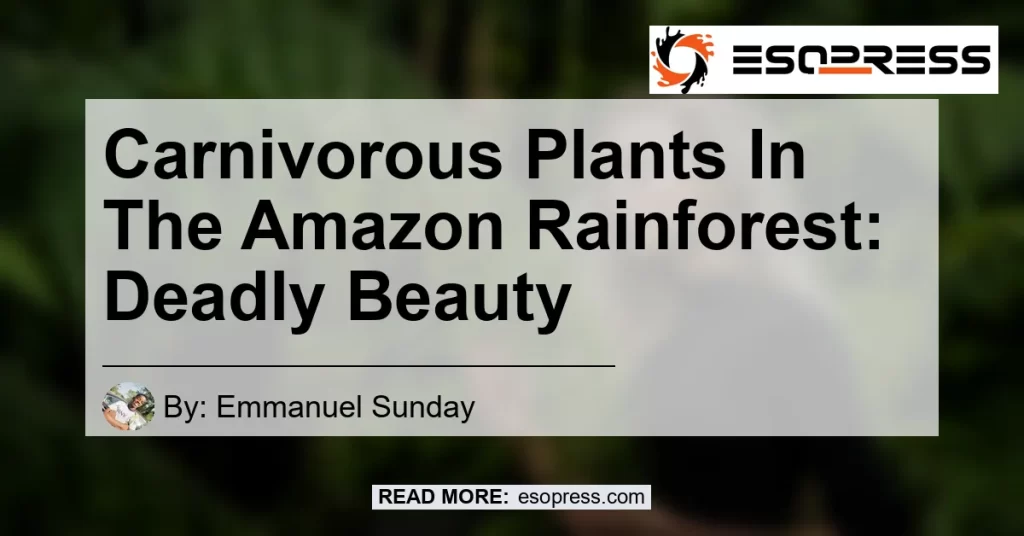

In the lush and vibrant Amazon rainforest, a remarkable group of plants has evolved to defy our expectations – the carnivorous plants. While most plants gather nutrients directly from the soil, these unique specimens have adapted to survive in low-nutrient habitats by supplementing their diet with animal prey. In this article, we will delve into the mysterious world of carnivorous plants in the Amazon rainforest, exploring their adaptations, hunting mechanisms, and highlighting some of the most fascinating species you can find in this remarkable ecosystem.
Contents
- 1 Understanding Carnivorous Plants
- 2 The Importance of Carnivorous Plants in the Amazon Rainforest
- 3 Exploring the Amazon Rainforest: A Treasure Trove of Breathtaking Beauty
- 4 The Best Product for Carnivorous Plant Enthusiasts: The Nepenthes Carnivorous Plant Kit
- 5 Conclusion: A World of Meat-Eating Plants Awaits in the Amazon Rainforest
Understanding Carnivorous Plants
Carnivorous plants are a diverse group of flora that has independently evolved across different regions of the world. These plants have developed specialized structures and mechanisms to capture, kill, and digest small animals. Unlike their non-carnivorous counterparts, they are not solely dependent on photosynthesis for their nutrient needs. Instead, they have adapted to supplement their diet with insects, spiders, and other small invertebrates.
An Adaptation to Low-Nutrient Environments
The Amazon rainforest is known for its incredible biodiversity and abundance of plant life. However, even in such a nutrient-rich environment, there are pockets of low-nutrient soil where many plants struggle to survive. This is where carnivorous plants have found their niche. By capturing and digesting animal prey, they are able to obtain the vital nutrients they need to thrive in these challenging conditions.
The Hunting Mechanisms of Carnivorous Plants
Carnivorous plants employ a variety of hunting mechanisms to capture their prey. Some species, like the pitcher plants, have specialized leaves that form a tubular structure resembling a pitcher. This pitcher is filled with a digestive fluid that attracts insects. Once an insect enters the pitcher, it becomes trapped and is gradually broken down by enzymes released by the plant.
Other carnivorous plants, such as the Venus flytrap, utilize a snap-trap mechanism. These plants have modified leaves with trigger hairs that, when stimulated by the presence of an insect, cause the leaves to snap shut, ensnaring the prey. The trapped insect is then slowly digested by enzymes secreted by the plant.
The Fascinating Species of Carnivorous Plants in the Amazon Rainforest
-
Pitcher Plants (Nepenthes) – The pitcher plants are some of the most iconic carnivorous plants in the Amazon rainforest. With their distinctive pitcher-shaped leaves, they lure insects into their deadly traps. These plants are remarkable not only for their hunting mechanisms but also for their vibrant colors and intricate patterns, making them a sight to behold in the dense rainforest.
-
Butterworts (Pinguicula) – Butterworts are another group of carnivorous plants found in the Amazon rainforest. They possess sticky leaves that secrete a digestive enzyme. Insects attracted to the nectar on the leaves become trapped in the adhesive, leading to their demise. Butterworts are known for their beautiful flowers, which serve to attract pollinators.
-
Sundews (Drosera) – Sundews are renowned for their striking appearance. These plants have leaves covered in glistening, tentacle-like structures that are tipped with sticky secretions. Insects that land on the leaves become trapped in the sticky mucilage and are slowly digested by enzymes. Sundews are excellent indicators of the health of their ecosystem, as they are sensitive to changes in environmental conditions.
The Importance of Carnivorous Plants in the Amazon Rainforest
Carnivorous plants play a crucial ecological role in the Amazon rainforest. By preying on insects and other small invertebrates, they help to control populations of these organisms. Additionally, they contribute to nutrient cycling within the ecosystem by recycling organic matter and releasing essential nutrients back into the environment. Furthermore, their unique adaptations and existence provide valuable insights into evolutionary processes and the diversity of life on our planet.
Exploring the Amazon Rainforest: A Treasure Trove of Breathtaking Beauty
The Amazon rainforest is not only home to an incredible array of carnivorous plants but also hosts countless other fascinating species. From vibrant orchids to towering trees and elusive animals, this biodiverse ecosystem never fails to awe and inspire. Exploring the Amazon offers a once-in-a-lifetime opportunity to witness the wonders of nature and deepen our understanding of the delicate balance that sustains life on Earth.
The Best Product for Carnivorous Plant Enthusiasts: The Nepenthes Carnivorous Plant Kit
If you’re fascinated by carnivorous plants and want to cultivate your own mini Amazon rainforest ecosystem at home, we recommend the Nepenthes Carnivorous Plant Kit. This kit contains everything you need to start growing your own pitcher plants, including seeds, soil, and detailed instructions. With its high-quality components and excellent customer reviews, this kit is the perfect choice for both beginners and experienced plant enthusiasts.
To get started on your carnivorous plant journey, check out the Nepenthes Carnivorous Plant Kit on Amazon here.


Conclusion: A World of Meat-Eating Plants Awaits in the Amazon Rainforest
In conclusion, the carnivorous plants of the Amazon rainforest are a testament to the incredible adaptability and diversity of life on our planet. These remarkable plants have evolved unique hunting mechanisms to capture and digest animal prey, allowing them to thrive in low-nutrient environments. Their existence not only adds to the awe-inspiring beauty of the rainforest but also plays a vital ecological role. If you’re captivated by these fascinating flora, consider delving deeper into their world by exploring the Nepenthes Carnivorous Plant Kit – the perfect gateway to the captivating realm of carnivorous plants.






